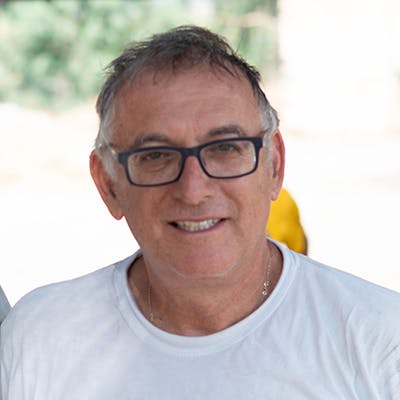In this presentation, Professor R. Steven Notley of Alliance University (formerly Nyack College) and Dr. Mordechai Aviam of Kinneret College on the Sea of Galilee will explore the historical and religious implications of the fifth- to eighth-century basilica excavated at Khirbet el-Araj (Bethsaida) from 2019 to 2022. In the absence of an alternative church, since 1921 both scholarly and popular writings have redirected the Byzantine testimony for a basilica built over the house of Peter to the “Octagon” (as its excavator, Gaudenzio Orfali, called it) in Capernaum. Yet, this modern innovation stands in the face of centuries of Christian tradition that consistently identified Peter’s home in Bethsaida, not in Capernaum.
For six seasons, the Kinneret Institute for Galilean Archaeology and Alliance University have excavated the archaeological site of el-Araj (Bet HaBek) on the northern shore of the Sea of Galilee. Beneath the former nineteenth-century house of Abdul Rahman Pasha Bek, three distinct layers have been identified in Area A. In the upper layer, which dates to the Crusader and Mamluk period, a sugar manufacturing structure was discovered. Below it is a monastery dating to the Byzantine and Early Islamic period, the fifth to the eighth century. It was constructed around a large basilica paved with mosaic floors. The basilica, or church, was described by the Bavarian bishop Willibald from his visit in 724, where he reports that it was built over the house of the apostles Peter and Andrew.
During the 2022 season, we were fortunate to find a complete Greek inscription that mentions, “the chief and commander of the heavenly apostles,” a clear reference to St. Peter. The inscription confirmed this is the church visited by Willibald! About two meters below the floors of the monastery, we uncovered a layer dated to the Roman period. Pottery and coins date from first to the third century. This is clear proof that the site, which was already suggested by scholars years ago, is indeed a good candidate for New Testament Bethsaida.
In addition, excavations in the surrounding Areas B, C, and D have found houses and rooms dated only to the Roman period, with coins from first to third century and pottery from first century BC. Limestone vessels, typical of Jewish populations, were found in the lower layer of these outlying squares. There are even coins minted by Herod Phillip, who is credited with transforming the village of Bethsaida into the city of Julias. There remains little doubt that the site of el-Araj was inhabited from the first century BC onward and probably began as a Jewish village. The existence of a public, well-decorated bathhouse in the Roman period shows signs of urbanization in what had previously been a rural site.
In this presentation, we will consider the most recent results from the 2022 season at Khirbet el-Araj and the relevant Byzantine pilgrimage itineraries. We will demonstrate that there is little doubt that the newly excavated basilica at Bethsaida/el-Araj should be identified with the basilica visited by centuries of Byzantine pilgrims to commemorate the house of St. Peter in Bethsaida.
Header photograph from the El Araj Archaeological Excavations Project.
Speakers

Dr. R. Steven Notley

R. Steven Notley is distinguished professor of New Testament and Christian origins at the New York City campus of Alliance University and director of the graduate programs in ancient Judaism and Christian origins. He received his PhD from the Hebrew University, where he studied with David Flusser. Dr. Notley lived for 16 years in Jerusalem with his wife and four children, during which time he was the founding chair of the New Testament Studies program at the Jerusalem University College. He has been directing groups of students and laypeople to Israel and the eastern Mediterranean region for 30 years. He is the author of many books and articles and continues collaborative research and publication with Israeli scholars in the fields of historical geography, ancient Judaism, and Christian origins. Among his list of publications, he collaborated with Flusser on the historical biography, The Sage from Galilee: Rediscovering Jesus’ Genius; with Anson Rainey on the monumental biblical atlas, The Sacred Bridge: Carta’s Atlas of the Biblical World; and with Ze’ev Safrai on an annotated translation of Eusebius’s important description of Roman Palestine, Eusebius, Onomasticon: A Triglott Edition with Notes and Commentary. He rejoined Safrai for their second work, a pioneering collection and translation of the earliest rabbinic parables that provide the literary and religious context for the parables of Jesus, The Parables of the Sages. Since 2016, he has served as the academic director of the el-Araj Excavation Project in its search for first-century Bethsaida-Julias, the lost city of the apostles.

Dr. Mordechai Aviam

Professor Dr. Mordechai Aviam is a professor of archaeology in the Kinneret College on the Sea of Galilee in the Land of Israel Studies Department, as well as the founder and director of the Kinneret Institute for Galilean Archaeology. He specialized in classical archaeology and has focused his research on Galilee since 1977. From 1990 to 2001, he was the district archaeologist of Western Galilee for the Israel Antiquities Authority.
Professor Aviam has many years of experience accomplishing field surveys. He has excavated many salvage excavations. His central excavations have been: seven seasons at ancient Yodefat (Jotapata); two ancient synagogues at Baram; a Hellenistic-Roman fortress at Keren Naftali; 10 Byzantine churches and monasteries; for the last two years, together with Samford University, Alabama, at the ancient Jewish village at Shikhin; and co-director of the excavations of the Roman period farmstead at Tel Rekhesh, at which a first- to second-century synagogue was discovered working together with Japanese universities. He is currently director of the excavations at el-Araj (Bethsaida) on the north shore of the Sea of Galilee.